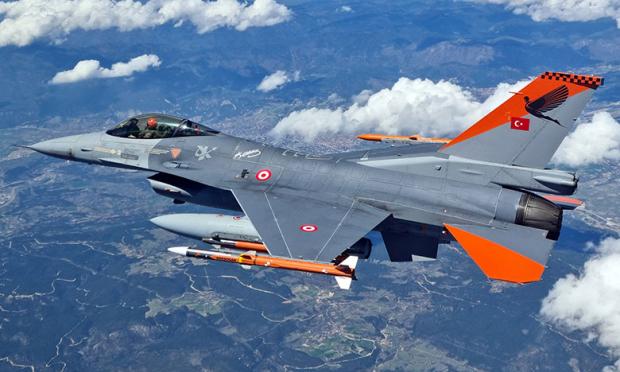In an earlier article a year earlier, we reported on the successful firing of the Turkish indigenous air-to-air missiles, Gökdoğan and Bozdoğan, by the neighbouring country's F-16 fighters.
Gökdoğan is one of the two missiles developed under the GÖKTUĞ project, equivalent to the US AIM-120 AMRAAM missile, while Bozdoğan is the equivalent of the AIM-9 Sidewinder.
A Turkish media article today reports that a contract has been signed for the GÖKDOĞAN and BOZDOĞAN missiles, noting:
"A contract has been signed for the supply of GÖKDOĞAN and BOZDOĞAN Air-to-Air Missiles developed by TÜBİTAK-SAGE within the framework of the GÖKTUĞ project.
A signing ceremony was held for the contract of the GÖKTUĞ F-16 PO-III low-scale initial production integration and procurement project of the GÖKTUĞ F-16 PO-III, which was initiated by the Presidency of Defence Industries (SSB) to meet the needs of the Air Force Command
Under the GÖKTUĞ Development Program, the GÖKDOĞAN and BOZDOĞAN missiles, which were developed to be integrated into the PO-I configuration of the F-16 aircraft, are being integrated into the PO-III configuration of the F-16 aircraft, and it was agreed to initiate low-scale initial production of GÖKTUĞ missiles to meet the Air Force Air Missile Command's needs.
The aim is to integrate the Bozdoğan and Gökdoğan missiles into the PO-III configuration of the F-16 aircraft and for the manufacturer to supply 25 Bozdoğan missiles, 25 Gökdoğan missiles and 14 launchers within 2025.
The GÖKTUG Project
Several difficulties are encountered in the procurement of AIM-9 and AIM-120 missiles from the United States, and their unit costs are very high.
These have forced Turkey to develop national air-to-air missiles.
In this context, TÜBİTAK-SAGE, which launched the GÖKTUĞ project in 2013, took an important step to end Turkey's dependence on foreign countries in this field.
The GÖKTUĞ project includes the construction of two indigenous air-to-air missiles, the BOZDOĞAN In-Sight Air-Air Missile (WVRAAM) and the GÖKDOĞAN In-Vision Air-Air Missile (BVRAAM).
The BOZDOĞAN In-Sight In-Air-Air-Sight Missile (WVRAAM)
The BOZDOĞAN is an in-vision air-to-air missile, equivalent to the US AIM-9X. The BOZDOĞAN, which features an infrared search system with a high-resolution image (IIR) image that provides the perfect out-of-sight angle, is resistant to electronic warfare.
The missile, which has a range of about 25 kilometers, can reach 3 times the speed of sound (3 Mach) and has high maneuverability.
Here is a comparison of BOZDOĞAN and AIM- 9X Sidewinder
Missile name: BOZDOĞAN AIM- 9X Sidewinder
Weight: 140 kg 84 kg
Length: 3.3 meters 10 feet
Diameter: 160 mm 127 mm
Range: 25+ km 30+km
Speed: 3+ Mach 2.5+ Mach
Type: In View In View
BOZDOĞAN is planned to replace the AIM-9 Sidewinder missiles in the Turkish Air Force Command's inventory.
The GÖKDOĞAN (BVRAAM) missile
The GÖKDOĞAN is the Over-Sight Air missile, equivalent to the US AIM-120 AMRAAM, with an active radar (AR) seeker head in solid state. The throw-forget is capable of locking on multiple targets, locking on after firing and firing from all angles.
The missile, which is resistant to electronic warfare, can be guided to the source of engagement, having a range of about 65 kilometers."
Conclusion
The ever cunning Turks, we can see from their article that they do not compare the GÖKDOĞAN with the American AIM-120 AMRAAM.The reason is obvious to us, since the Greek Air Force is known to have three types of AIM-120 - B, C-5, C-7 (AMRAAM) with a range of (B) 35NM, (C5) 40NM and (C7) 40NM respectively.
As it is known, the nautical mile is equivalent to exactly 1,852 meters and therefore the range of the AIM-120 (B) will be 35x1852=64820 meters, while the range of the (C5) and (C7) types will be 40x1852=74080 meters.
Therefore two (2) of the three AIM-120 AMRAAM types available in Greece have a range 9km longer than the Turkish GÖKDOĞAN, which is very critical for the engagement and shooting down of an F-16 fighter, with the balance tipping in favour of the Greek F-16s.
Finally, a major disadvantage of both Turkish-made missiles is that they have not been field-tested, which is extremely important for the reliability of any weapon system-means and ammunition.



